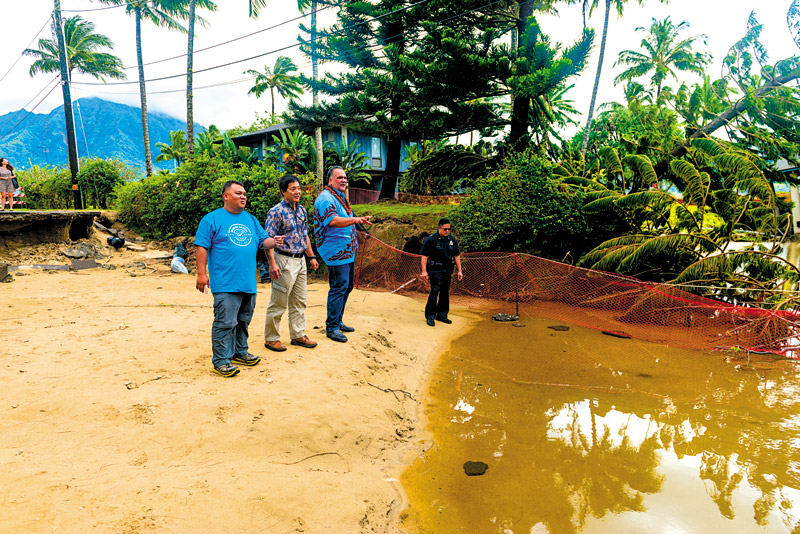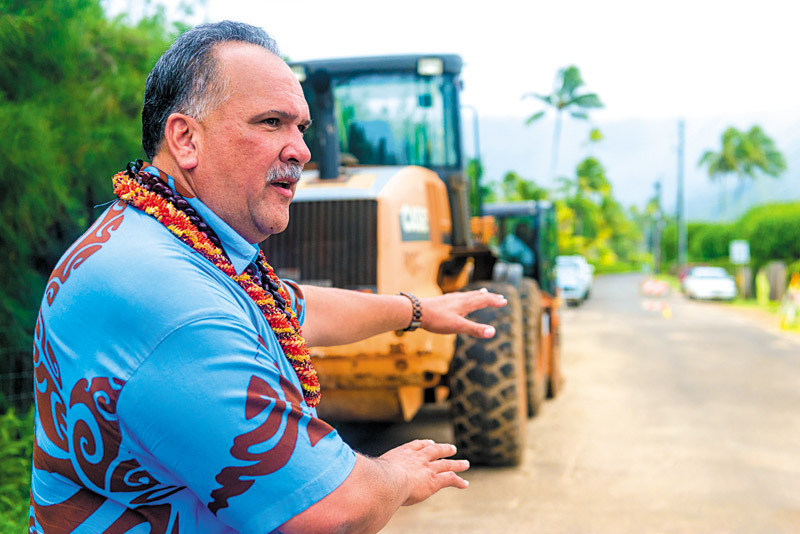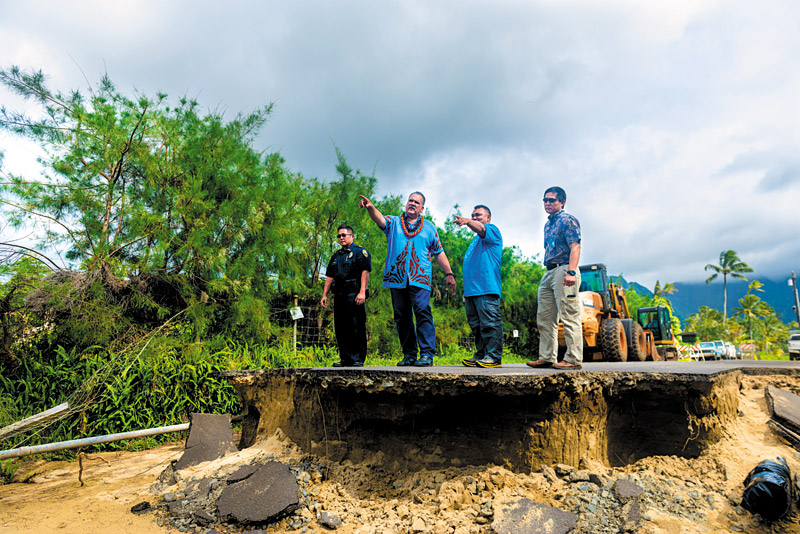Aftermath Of The Floods

Michael Dahilig, Elton Ushio, Mayor Bernard Carvalho Jr. and Bryson Ponce stand amidst the wreckage left behind from recent flooding.
The Garden Isle is still recovering after torrential rains and flooding, and Kaua‘i County is working to rebuild infrastructure to improve quality of life for all residents.
Historic rainfall bombarded the island during the early morning hours of April 15. While some were still safely tucked away in their beds at home, others were scrambling to safety as rivers rose and structures were inundated with water and mud.
Although significant portions of the island were affected by the deluge, thankfully, no one was harmed. And that’s in part due to the rescue efforts of county employees. During what Bryson Ponce, assistant chief with Kaua‘i Police Department’s Investigative Services, calls the “brunt of the flooding,” fire department personnel sprang to action. They grabbed paddleboards or whatever else was needed to move people away from rising water in places like Weke Road.
Ponce recalls the stories that poured in to Kaua‘i Emergency Management Agency that day. He played a role in coordination and communication efforts, and was also responsible for helping out with recovery the following day, making sure people who were trapped inside Wainiha and Hā‘ena were evacuated and that supplies made their way in.
Elijah Frank, Kaua‘i Fire Department rescue specialist, served as a point of contact for the community trapped on the North Shore and performed an initial rapid search and assessment of the damage to the major roads and neighborhoods.
“I was kind of in shock by what I saw and really did not have much time to think,” says Frank, who was displaced from his Wainiha home.
Damage was so extensive that the highway was closed from Waioli Beach Park, which isolated a portion of the island, requiring the combined efforts of many entities to get supplies and equipment to residents via barge, boat and helicopter. A school was opened, as well as a medical dispensary — everything needed to sustain a community. Moreover, there was no shortage of neighbors helping neighbors.
“That’s the magic and the resiliency of Kaua‘i,” says Mayor Bernard Carvalho Jr.
Ponce experienced this firsthand after spending some time in Wainiha and Hā‘ena following the storm.
“Whether they knew each other or not, they treated each other like family,” says Ponce of North Shore residents.
Michael Dahilig, the county’s planning director, spent more than two weeks in Wainiha and Hā‘ena and liked seeing people’s grit.
“It’s amazing to see how people, when they’re tested, really show their strength,” he says, “realizing that there’s a bigger picture rather than just themselves.”
Elton Ushio, the county’s emergency management administrator, agrees.
“Throughout the entire event thus far, what I’ve found most rewarding is a combination of the overall professionalism and dedication of the whole community team — partners at the county, state, federal and NGO levels,” he says. “In particular, the residents and affected populations have shown amazing resiliency, while still maintaining the aloha spirit.”
The state Department of Transportation opened one lane of traffic for residents on May 4 and, according to Shelly Kunishige of DOT’s public affairs office, there is still no “firm estimate for restoration” of two lanes until after the environmental and cultural documentation is complete. It is not expected that the road will be fully restored until sometime after October.
Frank says the remote North Shore region has been getting crowded over the years, and he hopes that some kind of balance will be restored to the area during this process, which entails determining whether the number of vehicles need to be restricted going forward.
“I think Kaua‘i residents should have equal access to the places we like to go without competing for a parking stall,” he says. “We need to ensure that we can still enjoy our own neighborhood if we want a welcomed visitor industry.”
There are still obstacles regarding flood recovery, like the restoration of Weke Road leading to Black Pot Beach Park.
“It’s not a memory yet, it’s still alive,” says Carvalho of the natural disaster.
Donations have been pouring in to address issues like road repair. Still, it’s a long haul for Weke Road. Before construction can even begin, a permitting process must occur that could take several months alone. Thus, there is no confirmed reopening date yet.
The North Shore isn’t the only area that received extensive damage. Kōloa and Keapana residents also suffered from Mother Nature’s wrath. In fact, Carvalho says one of the most touching stories from the event was of Richard Kaui in Keapana, who nearly lost his life trying to get away from rushing waters.
“But everything is good,” says Carvalho.
He adds that the county is taking accountability for the need to keep streams and rivers clear and clean, and take care of bridges, so that events of this nature where water is rerouted won’t happen again.
“We’re taking responsibility collectively,” he continues.
Despite some 380 residential households afflicted by flooding around the island, which doesn’t include vacation rentals like those on Weke Road or businesses, the community continues to work together and life is bouncing back in extraordinary ways.
“This experience has galvanized that unique culture that this island has,” says Dahilig, “and it’s a beautiful thing.”
County officials remind everyone that preparedness is essential and to always have at least one week’s worth of supplies on hand like batteries, food and water. Visit kauai.gov for more information.






